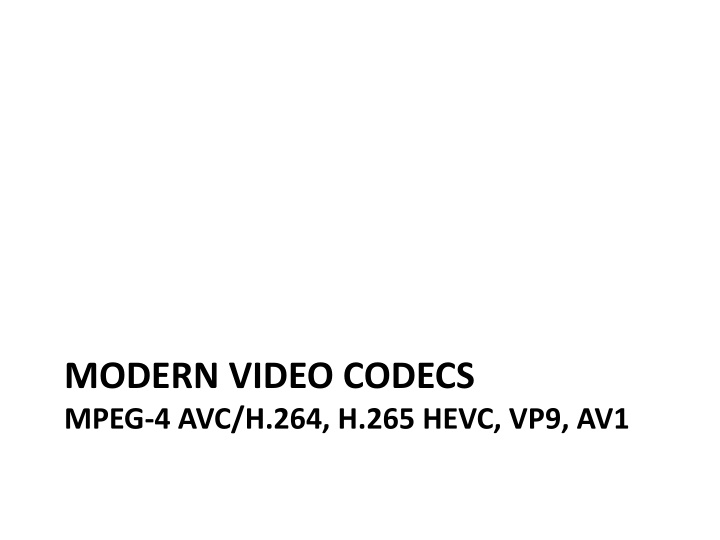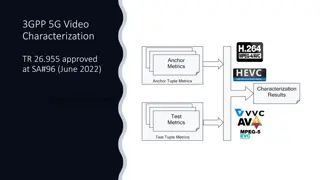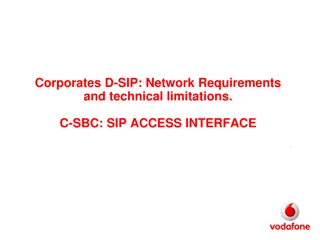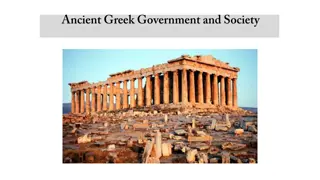MODERN VIDEO CODECS
MPEG-4 AVC/H.264 is a video codec developed jointly by ISO MPEG and ITU-T VCEG, reaching international standardization in 2003 with subsequent updates until 2007. It is conceptually divided into Video Coding Layer (VCL) for video encoding/decoding and Network Abstraction Layer (NAL) for transporting video over various transport layers. The codec features frame encoding with slices, flexible macroblock ordering (FMO), and multi-reference macroblock prediction, allowing for efficient video compression and quality. See detailed images illustrating the codec's architecture, slice types, and macroblock encoding methods.
Download Presentation

Please find below an Image/Link to download the presentation.
The content on the website is provided AS IS for your information and personal use only. It may not be sold, licensed, or shared on other websites without obtaining consent from the author.If you encounter any issues during the download, it is possible that the publisher has removed the file from their server.
You are allowed to download the files provided on this website for personal or commercial use, subject to the condition that they are used lawfully. All files are the property of their respective owners.
The content on the website is provided AS IS for your information and personal use only. It may not be sold, licensed, or shared on other websites without obtaining consent from the author.
E N D
Presentation Transcript
MODERN VIDEO CODECS MPEG-4 AVC/H.264, H.265 HEVC, VP9, AV1
MPEG-4 AVC/H.264 Developed jointly by ISO MPEG (Moving Picture Experts Group) and ITU-T VCEG (Video Coding Experts Group) Reached international standard in 2003 and subsequent parts were added up to 2007; after 2007 various amendment were still added Conceptually divided into Video Coding Layer (VCL) video encoding and decoding and Network Abstraction Layer (NAL) transporting video over various transport layers (RTP/IP, MPEG-2 TS etc.) Has 25 profiles
Frame encoding. Slices A frame is divided into slices (a group of macroblocks, not necessary consecutive) which are independently encoded and decoded If prev. standards had I/P/B frames, H.264 has I/P/B slices and the slice type determines the prediction modes available to macroblocks from the slide Arbitrary slice order (ASO) in the compressed bitstream Synchronization slice (SI for intracoding and SP for intercoding) a type of slice that enables efficient switching between streams or between different parts of the same stream
Slices. Flexible Macroblock Ordering (FMO) Picture is divided into slice groups and a slice contains a group of macroblocks. Macroblocks are allocated to slice groups according to a map (see fig.) A slice contains the macroblocks in raster-scan order from a slice group Corrupted macroblocks can be reconstructed from macroblocks from the same slice
Macroblock encoding a macroblock is partitioned into blocks in several ways (see fig.) max. 32 motion vectors can be used for 1 macroblock (if the MB is partitioned into 16 4x4 blocks) a MB can be predicted from max 32 frames (not just from 2 frames as for prev. standard B-frames) flexible multiple reference picture buffer Quarter-pixel accuracy for motion estimation
Macroblock encoding Quarter-pixel accuracy for motion estimation - Luma component predictions at half-sample locations are interpolated using a 6-tap FIR filter; predictions at quarter- sample locations are computed through a bilinear interpolation of the values for two neighbouring integer or half-sample locations. A MB can be encoded as a weighted average of other MBs from different frames Intraprediction modes (predicting pixel values inside a frame from neighbor samples):
Deblocking filter A filter used for smoothing block based video encoding In block-based encoding artifacts are obtained at the edges of the block The filter operates on a 4x4 grid on luma and chrominance components The filter is adaptive in order to eliminate encoding artifacts, but not produce excessive smoothing : it checks the quantization factor that is used on both sides of an edge if it is similar, the artifact is caused artificially and a stronger deblock filter is used, if the quantization factors differ significantly then the artifact is natural due to the edge and a finer filter is used
Discrete Cosine Transform H.264 performs DCT on 8x8 or 4x4 blocks H.264 uses a highly efficient integer approximation to the floating-point DCT: Let f be a 4x4 input block Let F be the output FDCT&quantisized 4x4 block ? = (? ? ??) ? where is the normal matrix multiplication and * is the Hadamard/Schur product (P=Q*R where pij=qij*rij) C is the core DCT transform matrix and S is the scaling+quantization matrix C = S =
Entropy coding Context-Adaptive Variable-Length Coding (CAVLC) simpler, one probability model is used based on previously encoded macroblocks Context-Adaptive Binary Arithmetic Coding (CABAC) more complex, several probability models are used
About VP9 VP9 is a open and royalty-free video coding standard developed by Google Used a lot on youtube Was extended to AV1 in 2018 by Alliance for Open Media (Google, Facebook, Amazon, IBM, Intel, Microsoft )
Macroblocks Allows macroblocks of various sizes from 16x16 to 64x64 A macroblock can be partitioned in many blocks of different sizes (recoursively, depending on color variation in a block):
Block prediction blocks are either inter predicted or intrapredicted interpredicted blocks : blocks can be predicted from one or two blocks from a different frame or two different frames (if the current block is predicted from 2 blocks from different frames, the pixel values are averaged between the 2 blocks) Intrapredicted blocks : pixels of a block can be predicted from other pixels from the same block (usually, the top-left, top- right, bottom-left, bottom-right pixels). Only the difference between the actual block and the predicted block is passed further to DCT and quantization
DCT Applies DCT on different block sizes: 8x8, 16x16, 32x32 It also introduced an ADST (Asymmetric Discrete Sine Transform) DCT and ADST are applied on a row or on a column (on one dimension)
Zig-zag parsing Special zig-zag order
About H.265 HEVC finalized in 2013 (1stversion), developed jointly by ITU.T VCEG group and ISO/IEC MPEG group the MPEG name : MPEG-H Part 2 the ITU.T name : H.265 the compression efficiency is twice the efficiency of H.264 at the same resolution and video quality the goals of H.265: Higher resolution (4K, 8K) Better compression Support for parallel processing architecture (multi-core, multi-cpu) Support for stereo and multiview capture
The HEVC encoder design G. Sullivan, J.-R. Ohm, W.-J. Han, T. Wiegand, Overview of the High Efficiency Video Coding (HEVC) Standard, TCSVT, vol. 22, no. 12, pp. 1649, 2012
HEVC main lines uses classical block-shaped region encoding, blocks ranging from 64x64 to 4x4 uses both inter-frame prediction (with motion vectors and motion compensation) and intra-frame prediction(i.e. pixels from the frame are predicted from other pixels from the same frame) instead of I/P/B frames, HEVC has I/P/B slices (slice=set of consecutive CTUs) instead of a 16x16 macroblock, HEVC uses CTU (Coding tree unit) which is made by 1 luma CTB (Coding tree block) and 2 chroma CTBs; a CTB is further splited into CB (coding block); 1 luma CB and 2 chroma CBs form a CU (Coding Unit) the decision of intra-frame prediction or inter-frame prediction is taken at the CU level Uses YCbCr colorspace with 4:2:0 subsampling for all processing
CTU, CTB, CB a frame is partitioned into CTUs (Coding Tree Unit) one CTU contains 1 luma CTB and 2 chroma CTBs a luma CTB can be 64x64, 32x32, 16x16 pixels and a chroma CTB can be 32x32, 16x16, 8x8 pixels a luma/chroma CTB can be used directly as a CB (Coding Block) end encoded or it can be further partitioned into multiple CBs the minimum size for a luma CB is 8x8 and for a chroma CB is 4x4 the CTU spliting process has a quadtree structure and the splitting is applied recursively until we reached the desired size of a CB or the minimum allowed size of a CB similarly, a CU (Coding Unit) is 1 luma CB and 2 chroma CBs
PBs (Prediction Blocks) and TBs (Transform Blocks) CTBs are first decomposed into a prediction quad-tree and the depth of the quad-tree goes from 64x64 to 4x4 pixels or the decoder can stop it at an intermediary depth; any node in the quad-tree has 4 children, except the leaf nodes (e.g. a 64x64 root quad-tree is first decomposed into 4 32x32 PBs) each leaf node in the quad-tree prediction is called a PB and it is encoded as either intra-predicted or inter-predicted, as residual error between the actual block and another one that predicts the actual block after the prediction quad-tree is computed and residual error is computed for all the pixels in a CTB, the CTB is further decomposed in another quad-tree, called the transform quad- tree
PBs (Prediction Blocks) and TBs (Transform Blocks) the transform quad-tree is computed in the same way as the prediction quad-tree (the leaf elements are now called TB) and the DCT transform is applied to each leaf node of the tree (i.e. to each TB) If the TB is 4x4 pixels, DST (Discrete Sine Transform) is applied by separating the prediction tree from the transform tree we can have a TB that is part of two separate PBs
Prediction Blocks and Transform Blocks decomposition In the following figure we can see a prediction quad-tree or a transform quad tree decomposition:
Intra-prediction and inter-prediction for intra-prediction HEVC has 35 prediction angles/directions while H.264 has only 9 for predicting pixels from neighboring samples quarter-pixel resolution is used for inter-prediction instead of I/P/B frames, we now have I/P/B slides many inter-prediction partitioning modes of a CB: symmetric modes: PART-2N 2N (CB is not split), PART-2N N (CB is split into two equal-size PBs horizontally), PART-N 2N (CB is split into two equal-size PBs vertically), PART-N N (CB is split into 4 equal size PBs) asymmetric partition modes: PART-2N nU, PART-2N nD, PART-nL 2N, and PART-nR 2N
Intra-prediction modes Pixels in a block are predicted from other pixels from the same slice/frame.
Slices and tiles a picture is divided into slides (composed from slides segments) or tiles (composed from tiles segments)
Transform and quantization DCT is applied on TBs of sizes 32x32, 16x16, 8x8 and 4x4 DST (Discrete Sine Transform) is applied on 4x4 TBs H.265 HEVC used matrixes of coefficients with integer approximations for the cosine and sine functions in the DCT and DST formulas quantization matrixes of 4x4 or 8x8 based on a Quantization Parameter (having values between 0 and 51) are used after quantization, a deblocking filter is applied just like in H.264 AVC
Entropy encoding for entropy encoding, CABAC is used similar to the way is specified in H.264 AVC, with minor modifications.
NAL (Network Access Layer) Units the Bitstream includes first global parameters (VPS,SPS,PPS etc.) and then a list of NAL units a NAL unit is an encoded frame/picture reading a NAL unit from the bitstream is described in the Annex B of the standard the syntax and semantics of the NAL Unit contents is described in section 7.3 of the standard decoding a NAL Unit is described in section 8.2 decoding a slice from a NAL unit is described in section 8.3 of the standard























